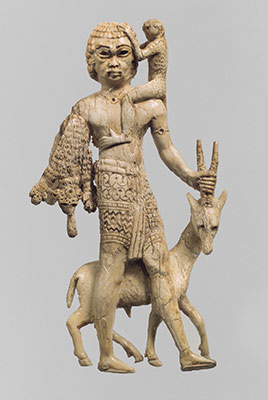Δημοσίευσηαπό Διάδοχος » 06 Μάιος 2017, 17:44
Freisinniger έγραψε:pluton έγραψε:Είναι βέβαιο ότι οι Έλληνες πήγαιναν στις Βαλτικές χώρες, έχει βρεθεί σε τάφους κεχλιμπάρι που μόνο στα κράτη Εσθονία κλπ υπάρχει.
εννοείται ότι πήγαιναν, ακόμη και στην αφρική
την Βρετανία την είχαν ονομάσει κασσιτερίδες νήσους, επείδη από εκεί βγάζαν κασσίτερο, ακόμη μέχρι και σήμερα η Μεγάλη Βρετανία βγάζει τόνους μολύβι και κασσίτερο.
Επρόκειτο για εμπορικούς δρόμους, όπως λ.χ. ο Δρόμος του Μεταξιού, έτσι υπάρχει και ο Δρόμος του Κεχριμπαριού απο τα προϊστορικά ακόμη χρόνια. Γιαγαντώθηκε κατά τους ρωμαϊκούς χρόνους.
Scientists presume that the trade in Amber started
as early as in New Stone Age. Amber, obtained in major excavation centres in Jutland and on eastern Baltic Coast began to spread in central Europe reaching even Egypt.
Baltic amber beads were found in 3400-2400 BC pharaoh tombs in Tethys pyramid. German archaeologist Heinrich Schliemann who in 1871-1890 excavated Troy in addition to other artefacts found amber beads. Scientists established that they were made from amber that had been brought from the Baltic Coast in 3000 BC. This archaeologist has found Baltic amber also in cupola tombs of Mycenaean Civilization built on Crete Island in 1600-800 BC.
In the 1st - 3rd centuries there was an intensive trade in amber with Roman Empire and its colonies and this led to the formation of so called Amber Road. Amber was treasured and called "northern gold" in Greece and in the Roman Empire. Transparent reddish or golden amber was especially valuable and was used in manufacture of adornments and small implements and utensils. Opaque amber was used only in the manufacture of incenses. Pliny the Elder in his work "Naturalis Historia" describes those times and tells a story about one Roman rider who managed to bring the quantity of amber with which it was possible to decorate not only an amphitheatre but also gladiators' clothes and arms. The biggest piece weighed over 4 kg. Amber destined for the Roman Empire was stored in intermediate points. Three such warehouses with 3 tons of amber have been found in the neighbourhood of Wroclaw. At around the end of the 3rd century new trade roads to the East by the Dnieper, Dniester and Prut Rivers have been found and relations with Slavic settlements, Roman colonies on the coast of the Black Sea and later with the Byzantine Empire and Arab countries established.
http://www.amberartisans.com/amberroutes1.html

Tο ότι υπήρχαν οι δρόμοι αυτοί, δεν σημαίνει ότι πηγαινοερχόταν τόσο συχνά από άκρη σε άκρη, κάτι τέτοιο γινόταν σπάνια. Δεν χρειζόταν κάτι τέτοιο για να μετακινούνται τα προϊόντα, όπως ακριβώς και με το μετάξι ή τα μπαχαρικά πριν τα πάρουν οι Ευρωπαίοι στα χέρια τους.
Την εποχή δε της εμπορικής θαλασσοκρατίας των αρχαίων ΕΛς, υπήρχαν και άλλοι παίκτες:
Trade in the Phoenician WorldTrade and the search for valuable commodities necessitated the establishment of permanent trading posts and, as the Phoenician ships generally sailed close to the coast and only in daytime, regular way-stations too. These outposts became more firmly established in order to control the trade in specific commodities available at that specific site. In time, these developed further to become full colonies so that a permanent Phoenician influence eventually extended around the whole coastline of the ancient Mediterranean and the Red Sea. Their broad-bottomed single-sail cargo ships transported goods from Lebanon to the Atlantic coast of Africa,
Britain, and even the Canary Islands, and brought goods back in the opposite direction, stopping at trade centres anywhere else between. Nor was trade restricted to sea routes as Phoenician caravans also operated throughout Western Asia tapping into well-established trading zones such as Mesopotamia and India.
...
The Phoenicians imported metals, especially copper from Cyprus, silver and iron from Spain, and gold from Ethiopia (and possibly Anatolia). This raw material was transformed into ornate vessels and art objects in Phoenician workshops and then exported.
Tin (from Britain), lead (Scilly Isles and Spain), and brassware were also traded, the latter principally coming from Spain. Ivory was imported from either Punt or India, as was ebony, both coming to Phoenicia via Arabia. Amber came either from the Baltic or Adriatic coast and was used in Phoenician jewellery. Embroidered linen and grain were imported from Egypt and fine, worked cloth from Mesopotamia. Grain, barley, honey, and oak timber used for oars on Phoenician ships, came from Palestine.
http://www.ancient.eu/article/881/

0 .
«Και η κουτσή Μαρία είναι εθνικιστές. Δηλαδή σε αυτό το επίπεδο; Εμείς είμαστε όλος ο πλανήτης!»
«Εμείς· οι Aλεξανδρείς, οι Aντιοχείς, οι Σελευκείς, κ’ οι πολυάριθμοι επίλοιποι Έλληνες Aιγύπτου και Συρίας, κ’ οι εν Μηδία, κ’ οι εν Περσίδι, κι όσοι άλλοι. Με τες εκτεταμένες επικράτειες, με την ποικίλη δράσι των στοχαστικών προσαρμογών. Και την Κοινήν Ελληνική Λαλιά ώς μέσα στην Βακτριανή την πήγαμεν, ώς τους Ινδούς. Για Λακεδαιμονίους να μιλούμε τώρα!»











